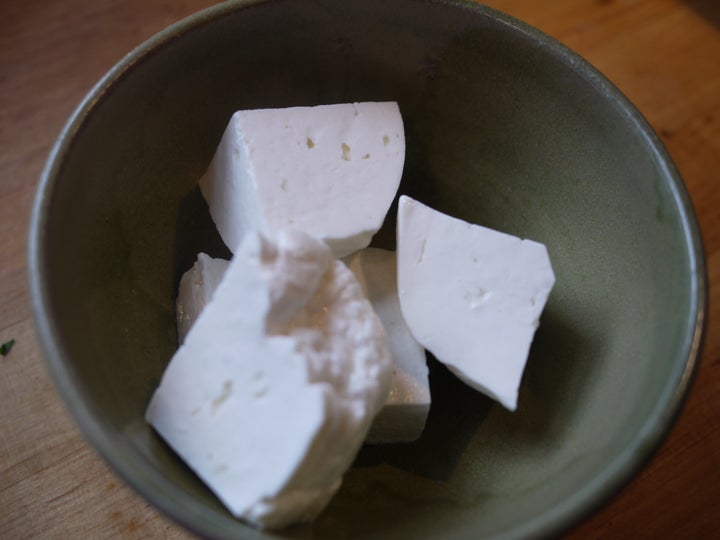
Greeks know their cheese. Statistics on cheese consumption place Greeks as the highest consumers (per capita) of cheese in the world. Yes, it appears that the average Greek consumes about 50-65 pounds (23-30 kg) of cheese a year. How? Blame it on the feta; at least half of that cheese consumed is feta. For Greeks, feta is like bread, it will be on every table regardless of what is being served. We eat it with vegetables, meat, beans, bread, and olives. We even eat feta with fruit, combining it with watermelon and cantaloupe.
This white salty cheese produced from sheep's milk, or a combination of sheep and goat's milk, has become popular outside of Greece because of it's taste and versatility. Nutritionally, it has fewer calories than some other cheeses not because it is lower in fat, but due to its higher water content. And since it has such an intense flavor and it is salty, you don't need to use large amounts. Traditionally, Greeks consumed mostly dairy in the form of cheese and yogurt made with sheep or goat's milk, the nutritional profile is different than that of cow's milk, having a higher content of essential fatty acids and minerals.
Here are some points to keep in mind when choosing feta.
Rule #1
Look at the ingredients. Make sure it only contains sheep's milk (and maybe some goat's milk), rennet and salt. It should not contain anything else nor should it contain cow's milk. Feta made with cow's milk (it isn't really feta) can crumble easily (that's not a good thing), may develop a sour taste and does not leave a pleasant aftertaste. Also it is more likely to become mushy and have a bad odor.
If you don't like the flavor of sheep or goat's milk and prefer cow's milk, than you probably won't like feta. Yes there is "feta" made with cow's milk, but it isn't feta.
Rule #2
Look for feta made in Greece. Feta is on the register of Protected Designations of Origin (PDO) in the European Union. That means that only feta produced with traditional methods, in certain parts of Greece and with Greek milk can be labeled or sold as feta. Now if you live outside of Europe, the law does not apply and you will see "feta" made anywhere and from anything: cow's milk, buffalo milk, with additives such as vegetable fat or protein, marinated in oil or herbs, with non-natural drainage, with no maturation process. Nope, that cheese is not feta, doesn't matter what the package says. We have to remember that even if the cheese is produced with traditional methods, the environment affects the milk produced by the animals that is used in the production of cheese. In Greece, small native breeds of sheep and goats have become extremely tough and resistant so that they could survive in that particular environment with diversified flora, giving feta its unique flavor. This cannot be reproduced.
If you can't find Greek feta, at least choose feta that is made from sheep's milk or a combination of sheep and goat's milk.
Rule #3
Taste it. If you have the luxury of being able to taste the cheese before you buy it, then do so. There are three different types of feta based on the texture: hard, medium-hardness and soft. There are also different aromas: some are saltier, some are spicy and some are mild. This all depends on what area and in what kind of container the feta is matured. Most Greek people have a favorite feta and they always buy that one. But you can also use different types of feta for different recipes. For example feta for a cheese pie -- tyropita maybe a bit saltier.
Rule #4
Feta should be white -- not yellowish. If it is a bit yellow, that means that the cheese has been exposed to air outside of the brine.
Rule #5
Feta should have a tangy flavor and a rich aroma. It should not taste bitter, sour, rancid, chalky or tasteless.
Rule #6
It should have a few tiny holes on the surface.
And one final point: I often read that pregnant women should avoid feta because it is made from unpasteurized milk; this is not true, almost all feta on the market (Greek) is pasteurized.
For easy ways to add feta to your cooking visit olivetomato.com